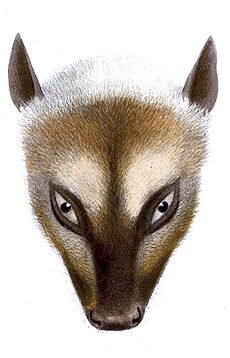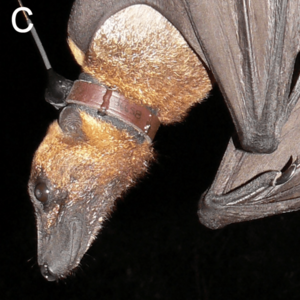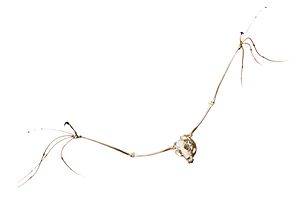Great flying fox facts for kids
Quick facts for kids Great flying fox |
|
|---|---|
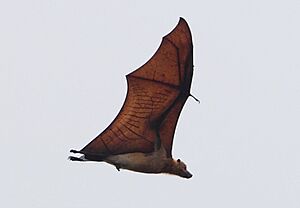 |
|
| Great flying fox in flight | |
| Conservation status | |
| Scientific classification | |
| Genus: |
Pteropus
|
| Species: |
neohibernicus
|
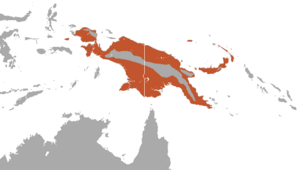 |
|
| Great flying fox range | |
| Synonyms | |
|
|
The great flying fox (Pteropus neohibernicus), also known as the greater flying fox or Bismarck flying fox, is a large type of bat. It belongs to a group called megabats. You can find it in the lowland areas of New Guinea and the Bismarck Archipelago.
This bat is one of the heaviest bats in the world. It can weigh up to 1.6 kilograms (about 3.5 pounds). It is also the largest bat found in a region called Melanesia. Great flying foxes are very social animals. They live in large groups called colonies with hundreds or even thousands of other bats. They eat fruits like figs and other special fruits. Even though they are hunted for food in some areas and have faced diseases, they are currently considered a species of "least concern" by conservation groups.
Contents
Discovering the Great Flying Fox
The great flying fox was first described in 1876. A German scientist named Wilhelm Peters gave it its scientific name. He first thought it was a type of black-bearded flying fox. The name neohibernicus comes from Latin. It means "of New Ireland," which is where the first bat was found.
Different Types of Great Flying Foxes
Scientists recognize two main types, or subspecies, of the great flying fox:
- P. n. hilli
- P. n. neohibernicus
The P. n. neohibernicus type lives on New Britain and mainland New Guinea. The P. n. hilli type is found on the Admiralty Islands.
Why So Many Names?
This bat has had many different scientific names over time. This is partly because its fur color can vary a lot. Some old names for it include Pteropus degener and Pteropus papuanus. Scientists studied these bats closely. They eventually realized these were all the same species.
Family Tree of the Great Flying Fox
Scientists use DNA to figure out how animals are related. One study from 2019 looked at the great flying fox's family tree. Based on some DNA, it seems most closely related to the spectacled flying fox. However, other DNA evidence suggests it's more closely related to the Pelew flying fox and the insular flying fox. This shows that their family history might be a bit complicated!
nuclear DNA (left) and nuclear and mitochondrial DNA (right)
| {| cellspacing=0 cellpadding=0 border=0 style=""
| style="width:1.5em;border-bottom:1px solid black;" valign=bottom align=center |
|-
|
||||||||||||||||||||||||||||||
|---|---|---|---|---|---|---|---|---|---|---|---|---|---|---|---|---|---|---|---|---|---|---|---|---|---|---|---|---|---|---|
| {| cellspacing=0 cellpadding=0 border=0 style=""
| style="width:1.5em;border-bottom:1px solid black;" valign=bottom align=center |
|-
|
||||||||||||||||||||||||||||||
|---|---|---|---|---|---|---|---|---|---|---|---|---|---|---|---|---|---|---|---|---|---|---|---|---|---|---|---|---|---|---|
What the Great Flying Fox Looks Like
The great flying fox is the biggest bat in New Guinea and all of Melanesia. Its forearm (the part of its wing from elbow to wrist) can be up to 20.7 centimeters (8.1 inches) long. These bats can weigh up to 1.6 kilograms (3.5 pounds). This makes them one of the heaviest bats known.
Male bats are usually larger than females. Males have longer bodies and bigger canine teeth. This bat does not have a tail. It has a long, narrow snout. The P. n. hilli subspecies is smaller than the P. n. neohibernicus type.
Fur Color
The fur color of the great flying fox can be different from bat to bat. It is often golden brown. The fur on its back is usually thin or missing. If there is fur on the back, it can be a reddish-brown color. Sometimes it's dark or pale brown. This reddish-brown fur often has some brownish-yellow hairs mixed in.
The fur is usually darkest on the sides of its back and hips. It is also dark on the top of its thighs. The fur is lightest in the middle of its back and hips.
It has a special "mantle" of fur. This is a contrasting color on the sides and back of its neck. The mantle is usually yellowish. The top of its head is darker than the mantle. The fur on its mantle and belly is longer than the fur on its back. The darker brown color on its head sometimes looks like a faint "T" shape.
Life and Habits of the Great Flying Fox
The great flying fox is a very social animal. It lives in large groups called colonies. These colonies can have thousands of bats. During the day, they rest in the tops of tall trees. These trees are often found along the coast. Many of their resting spots are close to where people live.
At night, the bats leave their resting spots to find food. They eat fruits, including figs and fruits from the Sapotaceae plant family. Sometimes, they even look for food during the day. They have been seen flying low over the sea to pick up fruits floating on the water.
Reproduction
Female great flying foxes usually give birth to one baby at a time. Near a place called Fulleborn in Papua New Guinea, it is thought that babies are born in early December. In the Bismarck Archipelago, females with half-grown young have been seen in June. Scientists think that male and female bats might live in separate resting places during part of the year.
Parasites
These bats can have tiny worms called nematodes living inside them. One type of worm, Litomosa hepatica, was first found in a great flying fox.
Where They Live
The great flying fox lives only on islands in the southwest Pacific. These include New Guinea, the Bismarck Archipelago, and the Raja Ampat Islands. These islands are part of Indonesia and Papua New Guinea. There is one record of this bat being seen on Thursday Island in Australia. They also live on very small islands like Karkar Island.
Scientists don't know why they don't live on other nearby large islands. These bats can be found from sea level up to 1,400 meters (about 4,600 feet) high. They live in both forests and savanna areas.
Protecting the Great Flying Fox
The great flying fox can be affected by diseases. In 1985, many dead and dying bats were found on Manus Island. This event lasted for several weeks. After that, no great flying foxes were seen on the island for years.
This bat species is listed in Appendix II of CITES. CITES is an agreement that helps control the trade of wild animals and plants. Appendix II means that trade must be carefully watched. This is to make sure the species does not become endangered.
The great flying fox is considered a common species. The IUCN (International Union for Conservation of Nature) lists it as a "least-concern species." This means it is not currently at high risk of extinction. However, it is not known if their numbers are growing, shrinking, or staying the same.
Great Flying Foxes and People
Scientists have studied the great flying fox to understand its role in nature. This includes looking at how it might be connected to the Hendra virus. This virus can affect humans. In Papua New Guinea, some great flying foxes have shown signs of having had the virus.
In Papua New Guinea, people hunt these bats for bushmeat, which means wild meat. Hunting happens across much of their home range. It is more common in some areas, like East Sepik Province. A report from 1984 said that local people caught the bats by hand or used arrows to hunt them.
The great flying fox is also part of local stories. In the Daribi language, there is a traditional story. It tells about a time when some Daribi men turned into great flying foxes. This bat has different names in different local languages. For example, it's called yolan in the Olo language and domwane in Daribi.



